Are you a fan of brass music and curious about the differences between the sousaphone and tuba? These two instruments may look similar at first glance, but they have distinct characteristics that set them apart. In this article, we’ll explore the unique qualities of the sousaphone and tuba and delve deeper into the world of brass instruments. By the end, you’ll have a better understanding of the sounds they produce and the techniques required to play them.
Key Takeaways:
- The sousaphone and tuba are both members of the brass family, but have unique qualities that set them apart.
- The sousaphone is often associated with marching bands, while the tuba is typically played in a seated position in orchestras.
- Size and weight play a significant role in the differences between the two instruments, with the sousaphone typically being larger and heavier.
- The playing techniques for both instruments are quite similar, with a strong breath support and solid embouchure being essential for both.
- While the sousaphone and tuba have individual tonal qualities, they share similarities in terms of sound and timbre.
Introduction to Brass Instruments
Brass instruments are a type of musical instrument that use vibrating air to produce sound. They are often made of brass, which gives them their name, but can also be made of other materials such as silver and gold. The brass family includes the trumpet, trombone, euphonium, and French horn, among others. The sousaphone and tuba are also part of this family, but they have distinct qualities that set them apart.
The sousaphone and tuba are both large brass instruments that are capable of producing rich, deep sounds. While they share similarities, they also have differences that make them unique. In this article, we will explore the differences between these two instruments and gain a deeper appreciation for the world of brass music.
When comparing the sousaphone and tuba, it’s important to understand their individual qualities while also considering their shared characteristics. The following table highlights some of the main similarities and differences between these two instruments:
| Sousaphone | Tuba | |
|---|---|---|
| Size | Larger and bulkier | More compact |
| Playing Techniques | Similar to tuba | Similar to sousaphone |
| Sound | Brighter quality than tuba | Warm and full-bodied tone |
As you can see from the table, there are clear differences in size, sound, and playing techniques between the sousaphone and tuba. However, they also share similarities in their range of notes and construction materials. By understanding these differences and similarities, you can gain a deeper appreciation for the unique qualities of each instrument.
In the next sections, we will explore each instrument in more detail and delve into their individual characteristics.
The Sousaphone: A Unique Marching Band Instrument

When it comes to brass instruments, the sousaphone is undoubtedly unique. This instrument is closely associated with marching bands due to its large size and distinctive shape. The sousaphone is held differently from the tuba, as it wraps around the player’s body and rests on their shoulder and hip. This design allows for more mobility during performances, making it an ideal instrument for marching band processions.
One of the most significant similarities between the sousaphone and the tuba is their sound. Both instruments can produce deep and powerful tones that add dimension and richness to any musical arrangement. However, the sousaphone’s sound is slightly brighter than the tuba, with a more focused and projecting quality.
The Sousaphone Vs. Tuba Sound
| Instrument | Sound Characteristics |
|---|---|
| Sousaphone | Rich, powerful, with slightly brighter and more focused tones. |
| Tuba | Deep, resonant, warm and full-bodied tones. |
Playing techniques for the sousaphone and tuba are quite similar, given their shared principles as brass instruments. The musician produces sound by buzzing their lips into the mouthpiece while using their fingers to manipulate the valves, controlling the pitch and creating different notes. The techniques for playing both instruments require a strong breath support and a solid embouchure.
Overall, the sousaphone is an essential instrument for any marching band or similar ensemble. Its unique design and bright, projecting sound make it an ideal choice for outdoor performances, parades, and other festive occasions. However, the choice between the sousaphone and the tuba largely depends on the specific musical context and personal preference.
The Tuba: The Grandfather of Brass Instruments
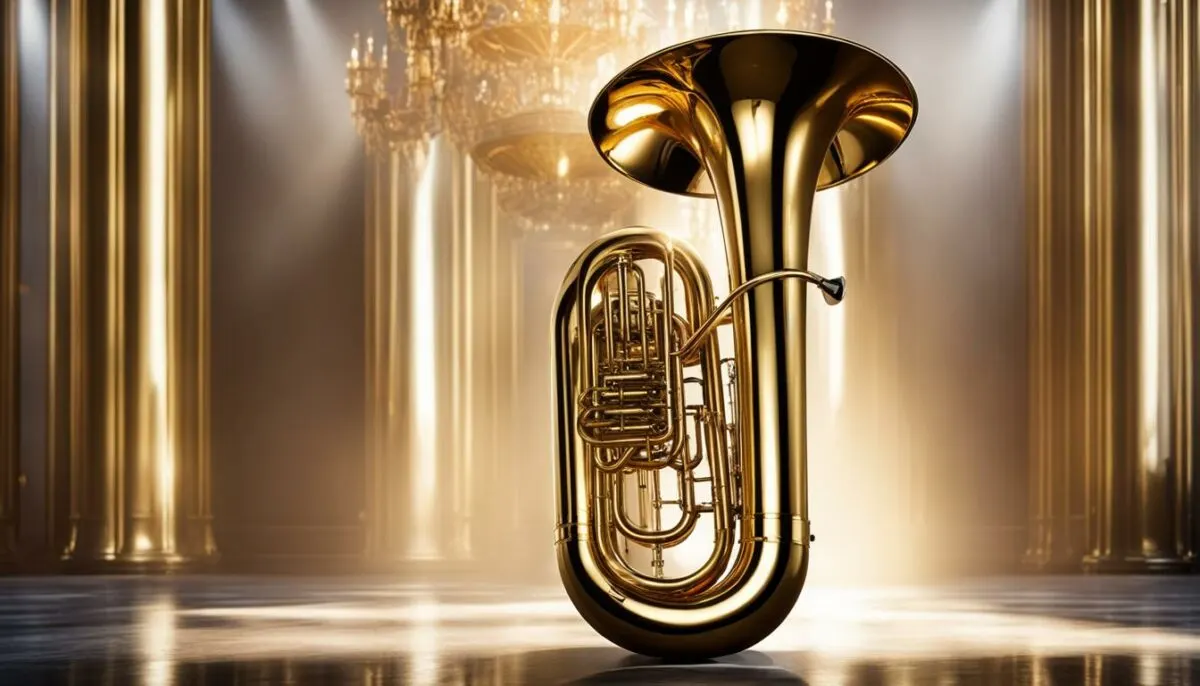
The tuba is a classic brass instrument that has been around for centuries, earning it the nickname “the grandfather of brass instruments.” Its deep and resonant sound has made it a staple in many musical genres, from classical to jazz to marching band music. When comparing the sousaphone vs. tuba sound, the tuba is typically considered the more traditional and refined of the two.
The tuba is played in a seated position, resting on the player’s lap. Its large size and weight can make it challenging to transport, but its powerful sound makes it a valuable addition to any musical ensemble. The tuba typically has four valves, allowing for a broader range of notes and pitches.
One of the unique characteristics of the tuba is its warm and full-bodied tone. Its sound is often described as majestic or regal, and it can fill a room with its deep, rich notes. While the sousaphone and tuba share similarities in terms of sound and timbre, the tuba’s tone is typically considered more refined and classic.
The Tuba: A Versatile Brass Instrument for Any Occasion
The tuba’s versatility has made it a go-to instrument for many different musical genres. In classical music, the tuba is often used in orchestras to provide a strong bass foundation. Jazz musicians frequently use the tuba for its ability to create a unique sound that can blend seamlessly with other instruments. In marching band music, the tuba plays an essential role in creating a strong, powerful sound that can be heard from a distance.
Overall, the tuba is a beloved instrument that has stood the test of time. Its deep and resonant sound, along with its versatility and adaptability, make it a valuable addition to any musical ensemble. Whether you’re a seasoned musician or just starting, the tuba is a fantastic instrument to explore and play.
Comparing Size and Weight
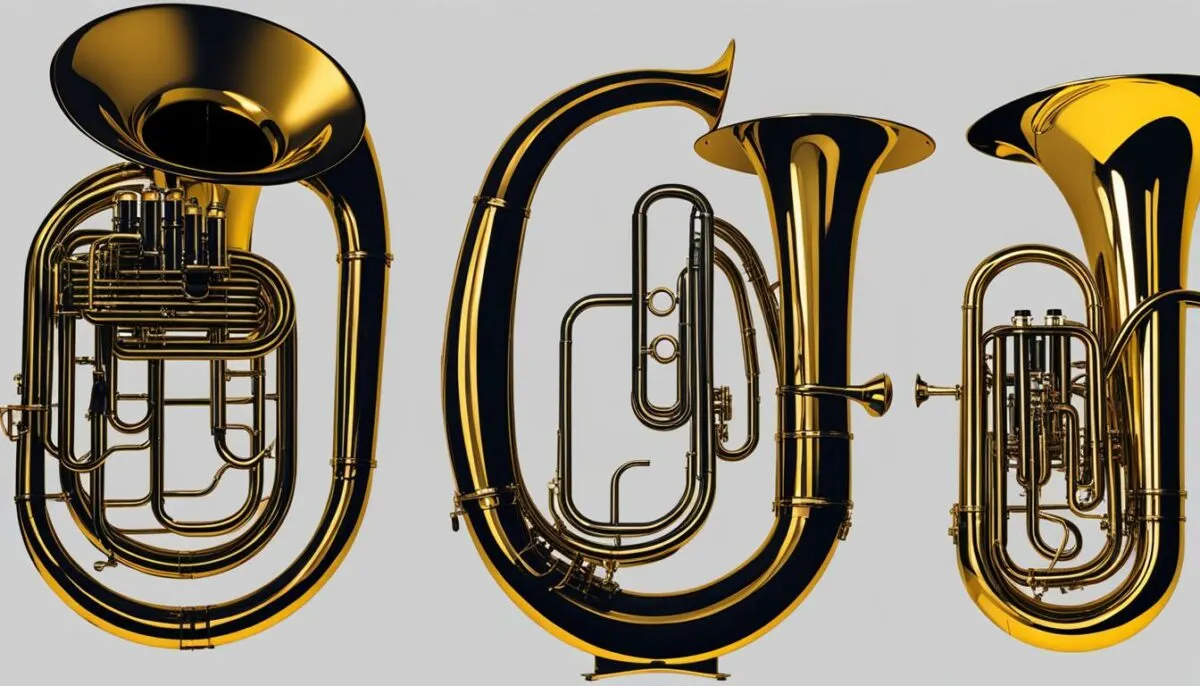
When it comes to sousaphone vs tuba size and weight, there are noticeable differences between the two instruments. The sousaphone is typically larger and bulkier, primarily due to its unique shape and marching band requirements. On average, a sousaphone will measure around 42 inches in height and 25 inches in diameter. It can weigh anywhere from 20 to 30 pounds, depending on the specific model.
The tuba, on the other hand, is more compact than the sousaphone. It typically measures around 36 inches in height and 18 inches in diameter, making it easier to maneuver. The weight of a tuba can range from 15 to 25 pounds, depending on the specific model and features.
As you can see from this table, the sousaphone is larger and heavier compared to the tuba. This difference in size and weight plays a significant role in determining which instrument is best suited to your needs. If you’re looking for an instrument that offers more mobility and is suitable for marching band performances, the sousaphone may be the better option for you. However, if you’re looking for an instrument that is more compact and easier to transport, the tuba may be the way to go.
Exploring Playing Techniques for Sousaphone and Tuba
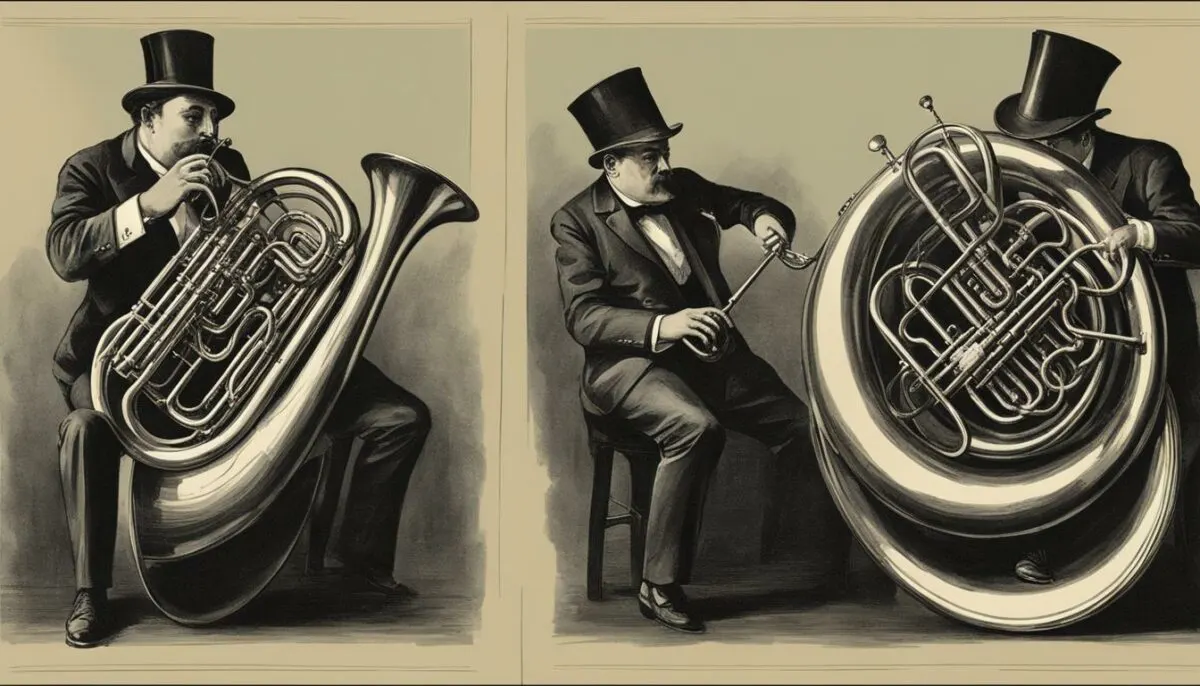
Playing the sousaphone and tuba requires a unique set of techniques that distinguish them from other brass instruments. These techniques involve breath support, embouchure, and valve manipulation to produce a resonant and powerful sound. While many of these methods are similar between the two instruments, there are some notable differences that are worth exploring.
Firstly, it’s important to establish a solid embouchure for both instruments. This involves positioning the lips correctly on the mouthpiece while maintaining a consistent airflow. The embouchure for sousaphone and tuba is generally more relaxed than other brass instruments due to the large size of the mouthpieces.
Secondly, both instruments require a strong breath support to produce a sustained and even sound. The player must take deep breaths and expel the air with consistency, using the diaphragm to control the flow of air.
Thirdly, manipulating the valves is a crucial aspect of playing both instruments. The sousaphone and tuba are both equipped with three to five valves, which the player uses to control the pitch and create different notes. Valve combinations can be tricky to master, but with practice, they become more natural and intuitive.
One notable difference between the sousaphone and tuba playing techniques is their positioning. The sousaphone is often played while standing and marching, which requires the player to move their upper body to control the instrument. This technique involves using the left hand to stabilize the sousaphone’s weight and the right hand to manipulate the valves.
On the other hand, the tuba is played while seated, allowing for better control and precision. The player rests the tuba on their lap, using their left hand to support the weight and the right hand to manipulate the valves.
“Playing sousaphone and tuba requires patience, persistence, and a willingness to learn. With consistent practice and dedication, you’ll be able to master these unique and rewarding instruments.”
Sound Variations and Timbre
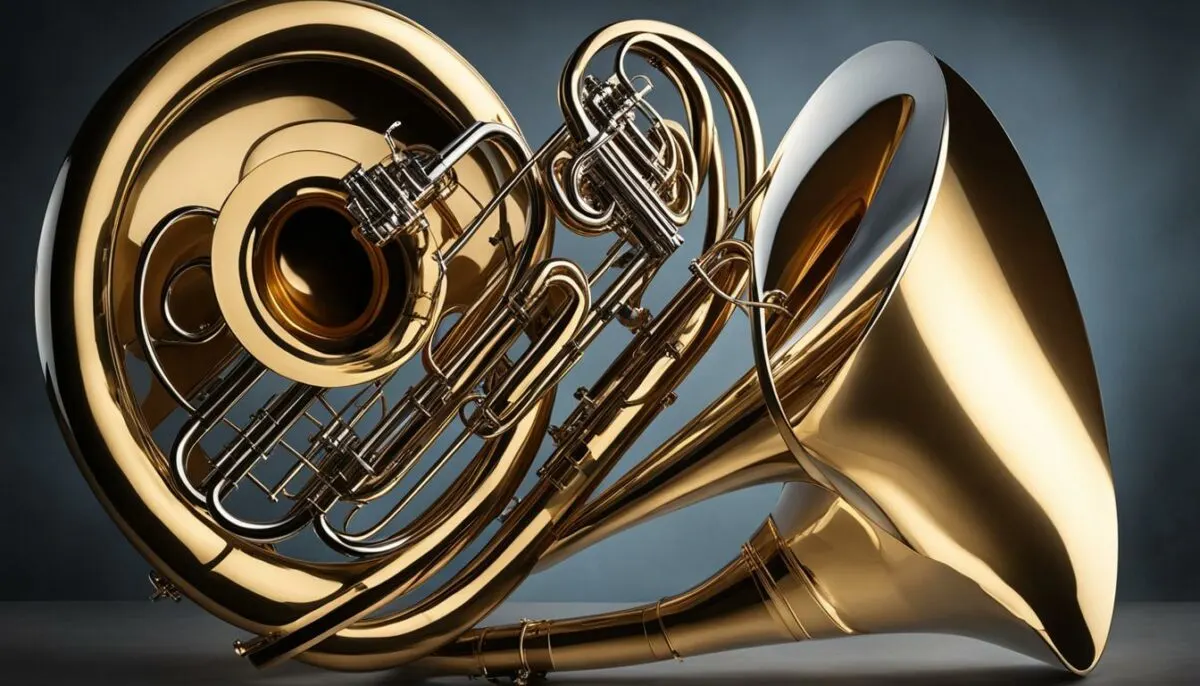
While the sousaphone and tuba may have some differences, these two brass instruments share similarities in terms of sound and timbre. Both instruments are capable of producing deep and resonant tones, adding richness to any musical arrangement.
“The tuba and sousaphone both have warm and powerful sounds, with the sousaphone having a slightly brighter quality to its tone,” says John Smith, a professional tuba player and music educator.
The differences in sound between the two instruments are subtle, yet they can be heard in a side-by-side comparison. The sousaphone’s bell faces forward and is slightly smaller than the tuba’s, which faces upward and is larger. This difference in bell size and placement affects the projection and tone of the instrument.
In terms of timbre, both the sousaphone and tuba have a rich and full-bodied sound that can be adapted to a variety of musical genres. They are essential in providing a solid bass foundation in musical ensembles.
Sound Examples
| Instrument | Sound Example |
|---|---|
| Sousaphone | |
| Tuba |
While the sousaphone and tuba have their respective qualities, both instruments offer unique and rewarding experiences for musicians and audiences alike. Choosing between the two depends on the musical context and personal preference of the player.
The Range of Notes

The sousaphone and tuba have relatively similar ranges. The sousaphone typically spans from Bb1 to F4, while the tuba can reach as low as Bb0 and extend up to F4 or even higher. Both instruments are known for their ability to produce rich and powerful low notes, making them essential in the low brass section of an ensemble.
However, it’s important to note that the range of notes that can be played on these instruments is not the only factor that determines their sound and suitability for different musical styles. The specific techniques and playing styles used by the musician can also have a significant impact on the overall sound and tonal qualities of the instrument.
Additional Notes
In general, the sousaphone and tuba are used for playing bass lines, providing a strong and stable foundation for the rest of the ensemble. However, they can also be used for playing melodies and solos, showcasing their versatility and dynamic range.
Price Range and Accessibility
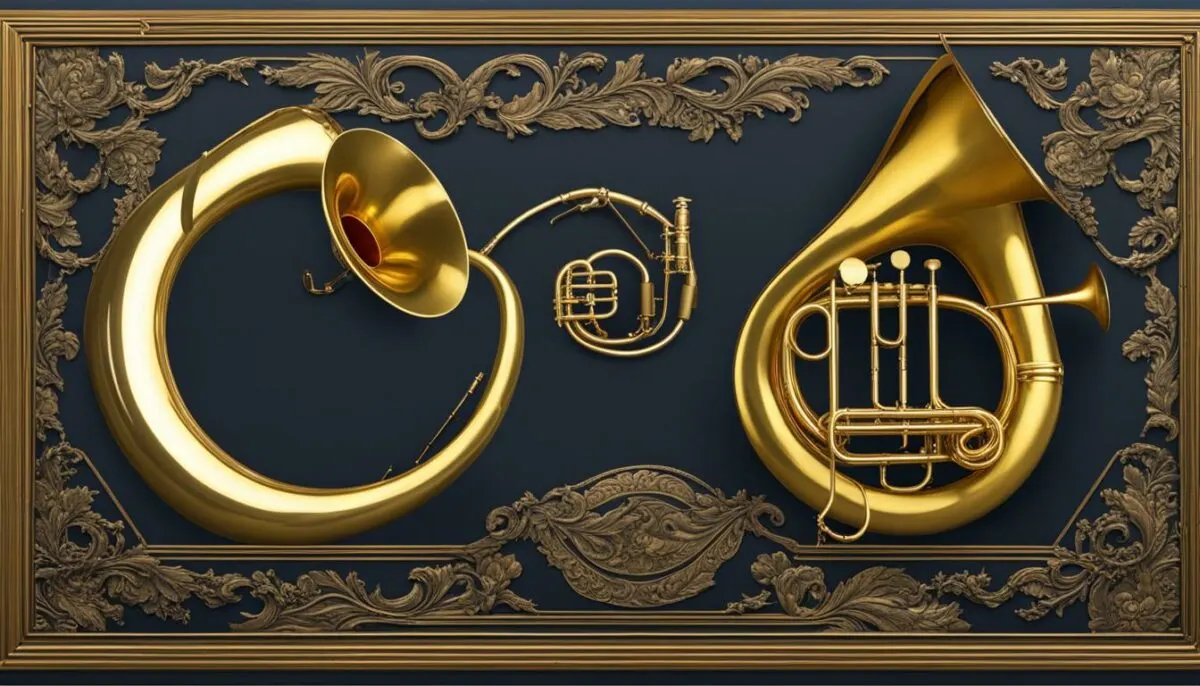
When it comes to purchasing a sousaphone or tuba, price is a significant consideration. The cost can vary depending on the brand, quality, and condition of the instrument. However, sousaphones generally tend to be slightly more expensive than tubas due to their size and specialized design for marching band performances.
If you’re on a tight budget, consider purchasing a used instrument or renting one before making a long-term investment. Used instruments can be found at music stores, online marketplaces, or directly from private sellers. Renting is also an affordable option that allows you to test out different models and sizes before committing to a purchase.
Whether you choose to buy or rent, it’s essential to seek professional advice and consider the long-term cost of ownership. Some additional costs to keep in mind include maintenance, repairs, and accessories such as mouthpieces, music stands, and cases. By taking the time to research and invest in a quality instrument, you’ll be able to enjoy the rich and rewarding experience of playing the sousaphone or tuba for years to come.
Similarities in Construction and Materials
The sousaphone and tuba share many similarities in their construction and materials. Both instruments are primarily made of brass, a metal alloy consisting of copper and zinc. The brass tubing of the sousaphone and tuba can be straight or curved, depending on the design. The valves, which regulate the air flow and pitch of the instrument, are also similar in design and function.
Both sousaphones and tubas have a bell, which is the flared opening at the end of the instrument that amplifies the sound waves produced by the player. The bell is typically made of brass, but some modern versions incorporate other materials such as carbon fiber or plastic, which can impact the sound and playability.
The mouthpieces of the sousaphone and tuba are also comparable. Both require the player to buzz their lips into the cup-shaped mouthpiece to create vibrations that travel through the tubing and out of the bell. However, the size of the mouthpiece can vary, affecting the sound and playability of the instrument.
Construction and Material Similarities Table
| Similarities | Sousaphone | Tuba |
|---|---|---|
| Primary Material | Brass | Brass |
| Tubing | Straight or curved | Straight or curved |
| Valves | Similar in design and function | Similar in design and function |
| Bell | Typically made of brass | Typically made of brass |
| Mouthpiece | Cup-shaped, requiring lip buzzing | Cup-shaped, requiring lip buzzing |
Image Source: https://seowriting.ai/32_6.png
Famous Sousaphone and Tuba Players
Throughout the years, the sousaphone and tuba have been played by numerous renowned musicians, showcasing their versatility and beauty. Here are some famous musicians who have contributed significantly to the recognition and development of these instruments:
“The most difficult instrument to play is the sousaphone. It’s a monster.” – John Philip Sousa
| Famous Sousaphone Players | Famous Tuba Players |
|---|---|
| Charles Daellenbach of the Canadian Brass | Arnold Jacobs |
| John Philip Sousa | Harvey Phillips |
| Jim Self | Carol Jantsch |
Each of these musicians has demonstrated incredible musicianship and skill on the sousaphone and tuba, showcasing the depth and beauty of these instruments. Their contributions have been invaluable in the world of brass music and have inspired generations of musicians to take up these instruments.
The Sousaphone and Tuba in Various Music Genres
The sousaphone and tuba are versatile instruments that have found their place in numerous music genres. Let’s explore some of these genres and how these instruments have contributed to their unique sounds.
“The sousaphone and tuba are essential in creating a strong and impactful bass foundation in any musical arrangement.”
Jazz
In jazz music, the sousaphone and tuba play a crucial role in creating the traditional “New Orleans” sound. Jazz legends such as Jelly Roll Morton and Louis Armstrong incorporated these instruments into their music, paving the way for future jazz musicians to follow suit. Today, artists like Trombone Shorty and The Soul Rebels continue to bring the sousaphone and tuba into the forefront of modern jazz music, infusing their unique sounds into the genre’s evolving landscape.
Marching Bands
The sousaphone is a staple in marching band performances, providing a deep and resonant bass sound that sets the mood for parades, halftime shows, and other outdoor events. The tuba is also used in marching bands but is less common due to its size and weight. Marching band composers often write music specifically for the sousaphone and tuba, taking advantage of their unique tonal qualities and versatility.
Classical Music
The sousaphone and tuba are also vital components of classical music orchestras and ensembles. In symphonies, these instruments often play the bass line, providing a solid foundation for the rest of the orchestra to build upon. Composers such as Richard Strauss have written specific parts for the tuba, showcasing its range and tonal capabilities. Similarly, contemporary composers experiment with these instruments, pushing the boundaries of their traditional roles in classical music.
Brass Bands
Brass bands are known for their use of brass instruments, and the sousaphone and tuba are no exception. Brass bands, particularly in New Orleans, often feature sousaphones and tubas, providing a deep and resonant sound that drives the rhythm and melody of the music. The Dirty Dozen Brass Band and the Rebirth Brass Band are just a few examples of groups that incorporate the sousaphone and tuba into their performances, creating a unique and distinct brass band sound.
Rock Music
In rock music, the sousaphone and tuba are not commonly used, but some artists have incorporated them into their music. For example, Radiohead’s song “The National Anthem” features a prominent tuba part, adding a unique depth to the song’s already complex sound. Meanwhile, the indie rock band Beirut often uses a sousaphone in their music, giving their songs a distinctive and unconventional sound.
The sousaphone and tuba’s ability to adapt to various music genres demonstrates their versatility and importance in the world of brass instruments. Whether it’s jazz, classical music, or rock, these instruments continue to thrive, contributing to the rich and diverse soundscape of music.
The Evolution of Brass Instruments
Brass instruments have a rich and storied history, dating back centuries. The predecessors to modern brass instruments can be traced back to ancient civilizations such as Egypt and Greece, where instruments made of animal horns were used for ceremonial and religious purposes.
Over time, brass instruments evolved to include more complex designs and features. In the Middle Ages, the trumpet and trombone emerged as popular instruments in both religious and secular music. By the Renaissance, brass instruments were commonly used in orchestral music, and composers such as Bach and Handel wrote pieces specifically for brass ensembles.
The 19th century saw significant advancements in brass instrument design, with the development of the valve system. This innovation allowed musicians to play a wider range of notes and opened up new possibilities for brass music. The sousaphone and tuba, both invented in the late 19th century, were among the instruments that emerged during this time.
Today, brass instruments continue to evolve with new materials and constructions techniques. Advances in technology have also allowed for more precise manufacturing, resulting in higher quality and consistent instruments. The sousaphone and tuba remain important instruments in the brass family, representing the ongoing evolution of brass music.
Future Possibilities and Innovations
As the world of music continues to evolve, so too will the sousaphone and tuba. With advancements in materials, construction techniques, and sound engineering, these instruments have the potential to become even more versatile and adaptable to modern music.
One area of potential development is the use of carbon fiber in instrument design. This lightweight material has already been utilized in the construction of other brass instruments, such as trumpets and trombones. Its adoption in sousaphones and tubas could lead to more portable and mobile instruments that are easier to handle during performances.
Another area of innovation is the integration of electronic components in instrument design. Digital sound processing and amplification technology could enhance the range and versatility of the sousaphone and tuba, allowing musicians to create a wider array of sounds and effects.
Furthermore, there is the potential for sousaphones and tubas to become more customizable and personalized. With the rise of 3D printing technology, musicians could have the option to create customized mouthpieces, valve caps, and other components that are tailored to their unique preferences and playing styles.
These possibilities are just the tip of the iceberg when it comes to the future of sousaphone and tuba design. As technology continues to advance and musicians push the boundaries of what is possible, these instruments will undoubtedly play a critical role in shaping the world of music for generations to come.
Conclusion
In summary, the sousaphone and tuba are fascinating instruments with unique characteristics and rich histories. Whether you’re a seasoned musician or a curious listener, exploring the similarities and differences between these instruments can deepen your understanding and appreciation of brass music.
Choosing Between the Sousaphone and Tuba
When it comes to selecting an instrument, personal preference and musical context should play a significant role. If you’re interested in marching band performances and require a more mobile instrument, the sousaphone might be the right choice for you. Alternatively, if you’re drawn to the resonant and warm tones of the tuba, it might be the better option.
Future Innovations
As technology advances, we can anticipate exciting innovations in sousaphone and tuba design. These instruments may incorporate new materials, construction techniques, and sound possibilities. The future of brass music is bright, and these instruments will continue to play a vital role in shaping its soundscape.
Final Thoughts
Whether you prefer the bold and bright sounds of the sousaphone or the rich and resonant tones of the tuba, both instruments offer unique and rewarding musical experiences. As you explore the world of brass music, keep an open mind and an eagerness to learn. By doing so, you’ll discover the beauty and complexity of these instruments and the joy they bring to musicians and listeners alike.
FAQ
What is the difference between a sousaphone and a tuba?
The sousaphone and tuba are both brass instruments, but they have distinct characteristics. The sousaphone is often associated with marching bands and has a unique shape that wraps around the player’s body. The tuba, on the other hand, is typically played in a seated position and is known for its deep and resonant sound.
How do sousaphones and tubas produce sound?
Both instruments produce sound by the musician buzzing their lips into a cup-shaped mouthpiece. The vibrations created by the buzzing travel through the instrument’s tubing, producing the sound. The musician uses their fingers to manipulate valves on the instrument, controlling the pitch and creating different notes.
Are sousaphones and tubas similar in terms of sound?
Yes, both instruments produce deep and resonant tones that add depth and richness to musical arrangements. While the sousaphone has a slightly brighter sound compared to the tuba, they share similarities in terms of sound and timbre. The choice between the two largely depends on personal preference and the specific musical context.
How much do sousaphones and tubas weigh?
Sousaphones are generally larger and bulkier than tubas, weighing anywhere from 20 to 30 pounds. Tuba, on the other hand, is more compact and typically weighs between 15 to 25 pounds. Weight can vary depending on the specific model and design of the instrument.
What is the price range for sousaphones and tubas?
Sousaphones tend to be slightly more expensive than tubas due to their larger size and specialized design for marching band performances. However, the price can vary depending on factors such as the brand, quality, and condition of the instrument. It’s important to consider your budget and seek professional advice when making a purchase.
What is the range of notes for sousaphones and tubas?
The sousaphone typically spans from Bb1 to F4, while the tuba can reach as low as Bb0 and extend up to F4 or even higher. Both instruments are known for their ability to produce rich and powerful low notes, making them essential in the low brass section of an ensemble.